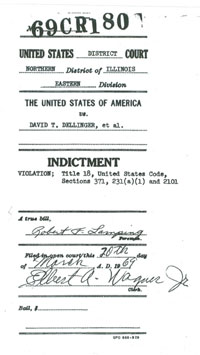
Aftermath of 'the whole world is watching': The Chicago 8 Trial
Aftermath of "the whole world is watching": The Chicago 8 Trial
The contentious, political, and cultural conflict of the sixties was exemplified in the events of the 1968 Democratic Convention, the civil disturbances and the subsequent Chicago 8 Trial.
Even before the August convention arrived in Chicago, the American people felt the turbulence of 1968. The Vietnam War raged with increased student protests on campuses. Martin Luther King, Jr.'s assassination in Memphis prompted violence in major American cities in the spring. And just two months later, Robert Kennedy was killed on the campaign trial in California while trying to secure the democratic nomination for president. Protestors, from the YIPPIES - the Youth International Party, to MOBE - the National Mobilization Committee to End the War in Vietnam made plans to come to Chicago for the Democratic National Convention.
Confrontation between protestors and Chicago policemen and the National Guard occurred throughout convention week. During the night of the actual democratic nomination, network TV aired scenes of law enforcement officers beating protestors in the streets as they chanted "the whole world is watching." The whole world was watching and was sickened.
Afterwards federal and local officials investigated the violence of the Convention and produced reports and sound bites. In September 1968, Chicago Mayor Richard J. Daley claimed the violence was a result of outside agitators, who provoked police and disobeyed rules. The National Commission on the Causes and Prevention of Violence report also noted that protestors agitated the police, but overall it emphasized the violence undertaken by the law enforcement. Days after the city's report was issued, Chief Judge William J. Campbell of the U.S. District Court, Northern Illinois, convened a grand jury to consider infractions of the new anti-riot law.
The 1968 Civil Rights Act included a section on rioting and the incitement to riot in response to the numerous anti-war protests. On March 20, 1969, the grand jury returned indictments on eight demonstrators: David Dellinger, Rennie Davis, Tom Hayden, Abbie Hoffman, Jerry Rubin, Lee Weiner, John Froines, and Bobby Seale. The trial of these individuals began on September 24, 1969 and lasted thirteen months.
Document
Record Group 21, Records of the District Courts of the United States, United States vs. David T. Dellinger, et al, United States District Court, Northern District of Illinois, Eastern Division.
- Indictment, Criminal Case 69CR180, March 20, 1969, United States vs. David T. Dellinger, et al., United States District Court, Northern District of Illinois, Eastern Division, Chicago, Record Group 21, Records of District Courts of the United States.
Guided Questions
- What parties were involved in the case?
- What criminal charges were issued against the defendants? What law(s) were they accused of breaking?
- What are some examples of the criminal charges listed in the indictment?
- Where do you think a poster like this was used?
The lawyers for the defendants were William Kunstler and Leonard Weinglass. The lead prosecutor was Thomas Foran with the assistance of Richard Schultz.
- Keeping the indictment insights in mind, how would you proceed to argue this case as the prosecuting attorney?
- If you were Kunstler or Weinglass, how would you proceed to defend your clients?
Extension Activities
Further Research and Reenactment:
Have students complete further research on the major players in this trial (prosecutor, defendants, Judge Hoffman, etc.) and prepare to "step into character" and portray their character in a role play of this significant court case.
Standards
National History Standards
Era 9: Postwar United States (1945-1970s)
- Standard 2C: The student understands the foreign and domestic consequences of U.S. involvement in Vietnam.
